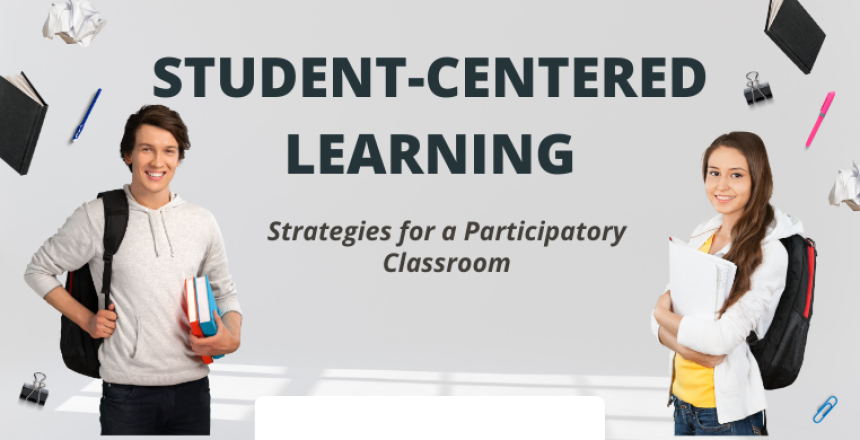Introduction:
In the realm of education, a paradigm shift towards student-centered learning has gained momentum, emphasizing the active involvement of students in their own education. This blog explores the principles and strategies that make a classroom truly student-centered, focusing on fostering engagement, collaboration, and a deeper understanding of the subject matter.
Understanding Student-Centered Learning:
Student-centered learning is an instructional approach that places the student at the center of the learning process. Unlike traditional teacher-centered methods, where the instructor is the primary source of knowledge, student-centered learning empowers learners to take ownership of their education. This shift is not only pedagogical but also philosophical, aiming to create a more dynamic and participatory educational experience.
Key Principles of Student-Centered Learning:
- Active Participation:
Encouraging students to actively engage with the learning material is fundamental to a student-centered approach. This can be achieved through discussions, problem-solving activities, and hands-on projects that stimulate critical thinking and creativity. - Collaborative Learning:
Collaboration among students fosters a sense of community and shared responsibility for learning outcomes. Group projects, peer teaching, and collaborative problem-solving activities promote teamwork and communication skills. - Inquiry-Based Learning:
Emphasizing inquiry-based learning encourages students to ask questions, explore topics of interest, and seek solutions. This approach cultivates curiosity and a love for learning, as students actively participate in the discovery process. - Flexibility in Learning Paths:
Recognizing that students have different learning styles and paces, a student-centered classroom allows for flexibility in learning paths. Providing options for students to choose topics, projects, or assessment methods caters to individual needs and preferences. - Feedback and Reflection:
Regular feedback, both from teachers and peers, is crucial for student growth. Additionally, incorporating reflection activities encourages students to assess their own progress, set goals, and develop metacognitive skills.
Strategies for Implementing Student-Centered Learning:
- Flipped Classroom Model:
The flipped classroom model reverses the traditional lecture and homework elements. Students engage with instructional content at home through videos or readings and use class time for interactive discussions, collaborative activities, and problem-solving. - Project-Based Learning (PBL):
PBL immerses students in real-world projects, applying theoretical knowledge to practical situations. This strategy promotes critical thinking, problem-solving, and collaboration, as students work on projects that have tangible, real-life implications. - Peer Teaching and Mentoring:
Encouraging students to teach each other not only reinforces their understanding of the material but also cultivates a supportive learning community. Assigning mentorship roles allows older students to guide their peers, fostering a sense of responsibility and collaboration. - Technology Integration:
Leveraging technology tools can enhance student-centered learning. Online platforms, educational apps, and virtual collaboration tools provide opportunities for interactive learning, personalized feedback, and the exploration of diverse educational resources. - Classroom Discussions and Socratic Seminars:
Facilitating meaningful classroom discussions and Socratic seminars encourages students to express their thoughts, question assumptions, and engage in critical dialogue. This strategy enhances communication skills and deepens understanding through peer interaction.
Challenges and Considerations:
- Resistance to Change:
Shifting to a student-centered approach may face resistance from both educators and students accustomed to traditional teaching methods. Providing professional development opportunities and demonstrating the benefits of this approach can help overcome resistance. - Assessment Alignment:
Traditional assessment methods may not align seamlessly with student-centered practices. Rethinking assessment strategies to evaluate not just knowledge retention but also critical thinking, collaboration, and problem-solving skills is essential. - Balancing Structure and Flexibility:
Striking the right balance between providing structure and allowing flexibility can be challenging. Educators must create a framework that guides learning while allowing room for student exploration and autonomy.
Future Implications:
- Lifelong Learning Skills:
A student-centered approach equips students with essential skills such as critical thinking, collaboration, and adaptability, preparing them for a future where continuous learning is crucial. - Global Citizenship:
Fostering a student-centered environment encourages cultural awareness, empathy, and a sense of global citizenship. Students learn to appreciate diverse perspectives and develop the skills needed to thrive in an interconnected world. - Technological Advancements:
As technology continues to evolve, the integration of artificial intelligence, virtual reality, and other innovations can further enhance student-centered learning, offering new possibilities for interactive and immersive educational experiences.
Conclusion:
In conclusion, embracing student-centered learning transforms the classroom into a dynamic and participatory space where students actively engage with the learning process. By implementing strategies that promote active participation, collaboration, and inquiry-based exploration, educators can nurture a generation of learners equipped with not only subject-specific knowledge but also the critical skills needed for success in an ever-changing world. While challenges exist, the potential for empowering students as active participants in their education positions student-centered learning as a key driver of educational innovation and excellence. The future of education lies in classrooms where students are not just recipients of knowledge but active contributors to their own learning journey.
